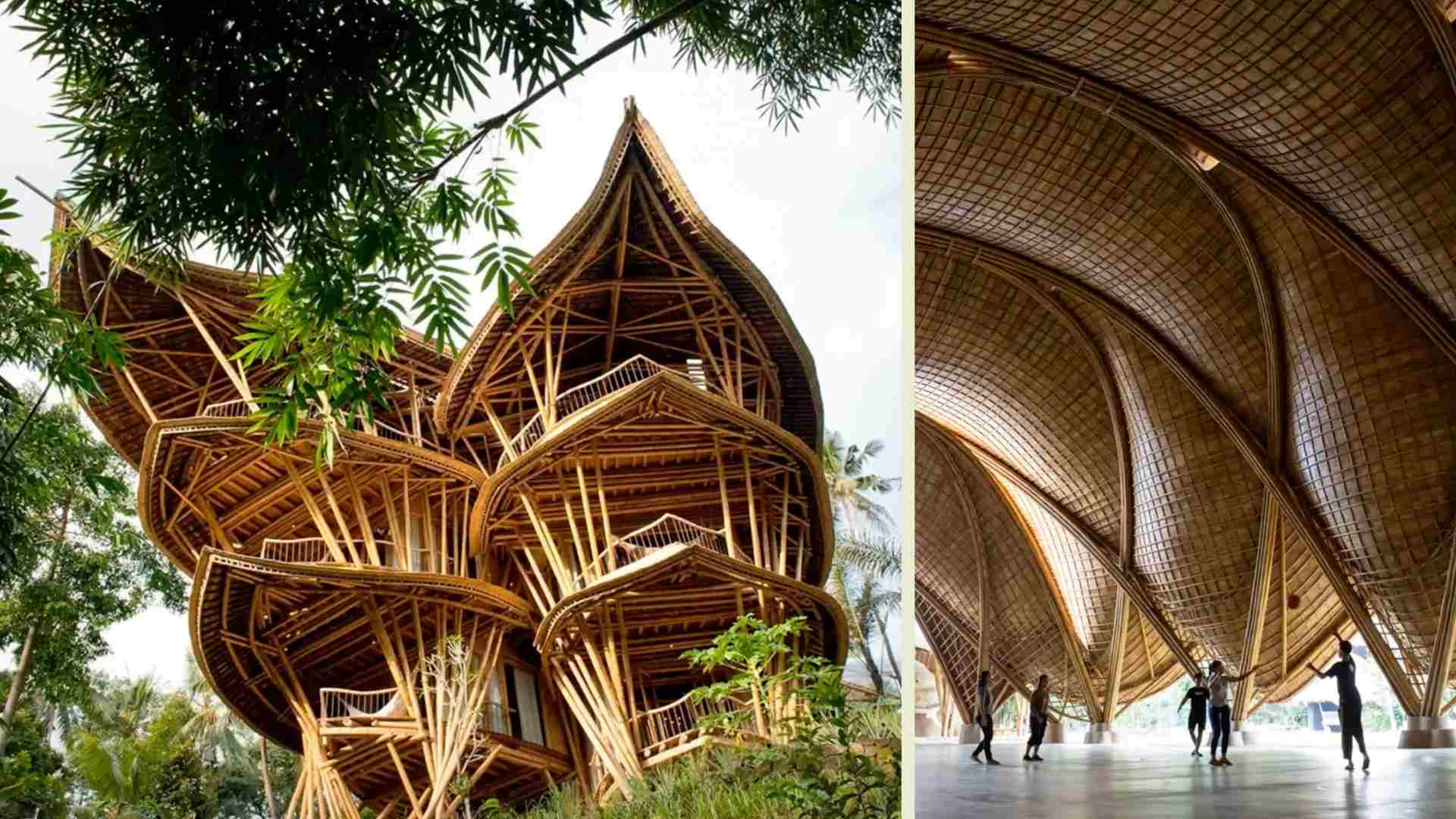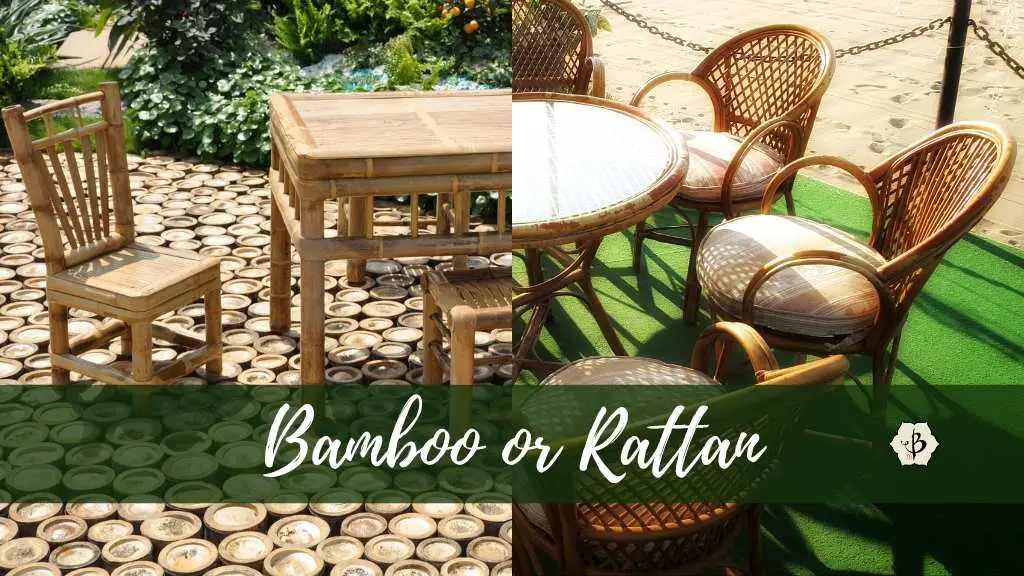The smooth, rounded design, the tropical vibe, the Asian aesthetic. So many reasons to love it. But is it bamboo, or is it rattan? The two plants have a lot in common and plenty of similar benefits.
The main difference between bamboo and rattan is that bamboo is a woody grass with hollow culms, and rattan is a liana, or a climbing member of the palm family, with solid culms. Both groups of plants include a wide variety of species. Especially prolific in tropical climates, bamboo and rattan are fast-growing and have a great number of practical uses.
Bamboo and Rattan
Round and woody, bamboo and rattan look very similar, but they are not closely related. Something they have in common is that they are both very renewable, fast-growing resources. For exactly this reason, INBAR, the International Bamboo and Rattan Organization, is a great proponent of both plants.
Bamboo is a woody grass
The primary distinction of bamboo is that it’s a grass. In fact, bamboo comprises a subfamily of the grass family (Poaceae) and includes about 1,500 different species and cultivars.
As a grass, they have a distinct morphology and growth habit. Like all grasses, bamboo has a hollow stem, called a culm. Small branches and leaves grow off the sides of the culms. Because most bamboo varieties are so much larger than other grasses, it is commonly thought of as a tree. The hard woodiness of this grass also reinforces that misconception.
But is bamboo always hollow? Indeed, there a few outlying species that actually have solid culms. Nature is filled with unusual exceptions. Read about Solid Bamboo species to learn more.
Another defining characteristic of grass is the way in which individual culms grow to their full height in a single season. Whereas a tree will continue to grow, slowly and steadily, year after year, a stalk of grass shoots up and reaches its full height in one growing season. In subsequent years, a bamboo culm will produce more leaves and branches, and its wood will harden, but it won’t get any taller.

The real year-over-year growth of bamboo is in the expansion of the clump. New shoots come up every year, and the grove grows wider and thicker.
Bamboo also has a far wider distribution than rattan. There are bamboo species native to every inhabited continent but Europe. Most endemic bamboo populations are concentrated around the equatorial tropics, but native bamboo grows as far north as Russia and as far south as southern Chile. It also flourishes throughout Africa and South America.
Rattan is a palm
Rattan includes about 600 species in the Calamoideae subfamily of palms. Unlike other palms, these are generally considered lianas, because they grow more like a vine. But unlike true lianas, rattan does not form branches. In this sense, they are more like other palm trees.
While bamboo grows all its height in one season, rattan continues to grow, little by little, year after year. Beginning in the shady understory of the tropical forest, rattan climbs its way up along the trunks of other larger trees. As it climbs, the stem twists and turns, not keeping straight and upright like bamboo. But the stem remains the same diameter as it gets older, growing only in length (or height). Some rattan plants can stretch several hundred feet long.
New growth on rattan is relatively soft and pliable, enabling it to crawl like ivy. But in time, it hardens like wood or like bamboo. The stems have small thorns or spines that give them grip and help them to climb on other trees. And the stems are always solid. The stems also have nodes, where leaves tend to grow, creating another resemblance to bamboo.
Technically a tree, rattan can grow as a solitary stem. But some species produce additional suckers, forming clumps, more similar to bamboo. In clumps, the separate stems can be harvested more sustainably and continuously, also like bamboo.
Certain varieties of bamboo, common in the Amazon and the Philippines, also have scandent or climbing growth habits. But for the most part, bamboo and rattan don’t look very similar when you see them growing.
Rattan’s distribution is somewhat limited compared to bamboo, growing mostly in India, Southeast Asia, the Philippines, and West Africa. Rattan is not endemic to the Western Hemisphere.
Rattan products
We are probably most familiar with rattan furniture and wicker basketry. It can be woven into all kinds of attractive crafts. You can tell the difference between bamboo and rattan furniture because rattan is solid and the canes usually have more bends and curves. (See features image, above.)
Unlike bamboo, rattan is not strong enough to use in building and construction. But it is useful enough to harvest aggressively, and over-exploitation is threatening its survival in many native habitats. Part of INBAR’s work is to train and encourage traditional workers to harvest and manage the rattan groves more responsibly and sustainably.
Less familiar to western consumers, rattan can be eaten. Some species produce an edible fruit. In India, it is not uncommon to eat the fresh shoots, similar to bamboo. As a palm, the heart of the rattan can also be a source of food.
Bamboo products
Useful and versatile as rattan may be, it’s no match for bamboo. Although it’s hollow, the wood of bamboo is much harder. And because the culms are long and straight, the lumber is much more useful.

Massive poles can be arranged to create amazing architectural structures. Long parallel strips of bamboo can be laminated together in a way that winding, sinuous rattan cannot.
Contemporary engineers have developed designs that involve curving the bamboo poles, but it doesn’t bend nearly as much as rattan. If you see bamboo tables and chairs with lots of rounded corners, or much more likely to be rattan. And if the poles are solid rather than hollow, that’s another good sign that it is rattan. But there are also some solid (or nearly solid) bamboo species that are commonly used to make furniture.
Further reading
I hope that gives you a better idea of the similarities and differences between bamboo and rattan. If you’re into building with readily renewable resources, you may also want to visit some of these other popular articles from Bambu Batu.

























